
|
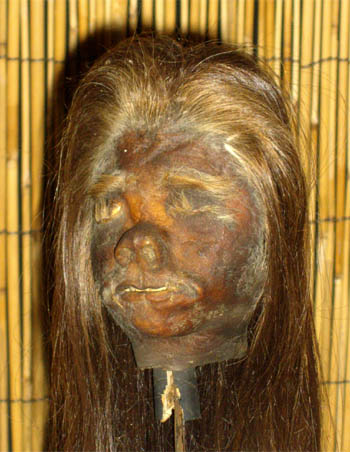
A
shrunken head in a musuem: fake or real? (Copyright
Lee Krystek, 2011)
|
The practice of head hunting - removing the head
of an adversary after killing him in battle as a trophy of the
victory - is historically widespread over much of the world.
In the 3rd century B.C. Chinese state of Qin, soldiers would
collect the heads of their fallen enemies and tie them around
their waist to terrorize and demoralize their opponents during
battle. In New Guinea, the Marind-anim tribe would take the
head of their enemies to control their spirits and would often
also cannibalize the flesh of their bodies. The Celts of Europe
also practiced headhunting up through the end of the Middle
Ages. A successful Celt warrior would nail the heads of his
enemies to his walls as a warning to others.
Despite the many forms of head hunting around
the world, only one group traditionally practiced the art of
taking a trophy human head and reducing it in size to that of
a man's fist. Head shrinking, as this practice has come to be
known, was the exclusive providence of the Jivaro Indians who
live in Ecuador and the nearby Peruvian Amazon. The Jivaro are
divided into smaller sub-groups which include the Shuar, Achuar,
Huambisa and the Aguaruna tribes.
The
Jivaro
When the Spanish conquered much of South America
starting in the 16th century, they found the Jivaro a difficult
problem. They were fierce warriors who were not easily subjugated.
According to records, in the year 1599 the tribes of the Jivaro
united in a revolt against the Spanish. Apparently 25,000 colonists
were killed during the attacks. During the uprising the Jivaro
raided the town of Logrono and took out their anger over a tax
on the gold trade by seizing the governor and pouring molten
gold down his throat.
|
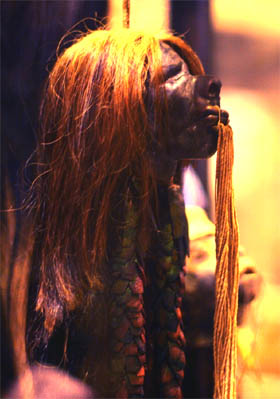
A
tsantsa on display in the Pitt Rivers Museum, Oxford.
The lower face and jaws jut outward as an artifact of
the shrinking process. (Credit Narayan
k28, licencsed through Creative
Commons Attribution
3.0 Unported)
|
After this rebellion the Jivaro territory, despite
its value as a gold-producing region, was never again under
Spanish control. This makes the Jivaro the only native group
to lead a successful uprising against their Spanish masters.
Their backlash against the conquistadors was so violent that
the word Jivaro soon entered the Spanish language with the meaning
"savage."
Because of outsider's fear of the Jivaro and the
remoteness of their dense, jungle territory, little was known
of them until the 20th century. What stories did come out, however,
were very frightening.
Despite their success on one occasion against
the Spanish, the Jivaro people never really united as a political
unit. Even though their customs, appearance, beliefs and culture
were very similar, they lived in small individual communities.
These groups were constantly at war with one another. While
around most of the world war is about gaining and controlling
territory, war for the Jivaro was about vengeance. Each killing
required retribution in a practice known as blood revenge.
The Jivaro feared that if they did not avenge the death of a
relative, then the spirit of that relative would be displeased
and cause all manner of bad luck for the tribe. In fact, the
Jivaro feared their own ancestors more than the spirits of those
whom they killed in their clashes.
During the raid of another village a warrior always
took care to retrieve the head of his victim by decapitating
it, passing a head band, or vine up through the throat, out
the mouth and then slinging it over his shoulder, allowing him
to make a rapid retreat. A raid might be considered a disappointment
even if several enemies were killed if no heads were recovered.
Making
a Shrunken Head
The practice of taking heads was common over much
of the world but the Jivaro added an extra step to the practice
through a process that creates what the Shuar tribe calls a
tsantsa.
|
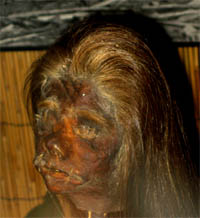
Be
Careful What You Ask For...
There
is a somewhat apocryphal story told of a red-haired European
man who traveled into Jivaro territory as an agent charged
with the commission of bringing out an authentic dried
and shrunken human head. Eventually when the head was
shipped back to the buyer, however, it was strange in
that the tsantsa had not the usual dark hair of a South
American native, but a glorious crown of red hair…
|
To start the tsantsa process, the flesh is first
peeled away from the skull by making an incision up the back
of the neck. The skull itself and its contents are discarded
into a nearby river. The warrior then sews the eyes closed and
the mouth is sealed by the use of small, sharp palm pegs through
the lips. At this point the skin is put into a boiling pot and
allowed to simmer for between an hour and a half and two hours.
The solution in the pot includes a number of herbs containing
tannin, a compound that will preserve the skin. The length of
time in the pot is critical as too short a time will result
in the head will not shrinking properly and the flesh on the
inside of the skin not loosening. Too long in the pot and the
hair on top of the head will fall out.
When the head is taken out of the pot it will
have shrunk to about one-third of its original size and have
a rubbery texture. The skin is turned inside out and any flesh
still adhering to the inside of the skin is scraped away. The
incision at the back of the neck is then crudely sewn back up
and the skin turned right-side out.
The next step is the drying process. The head
will continue to shrink during this stage as it is turned upside
down and filled with small rocks heated by a fire. When the
head gets too small for the pebbles, hot sand, heated in a bowl,
is used. Hot rocks are also applied to the outside of the head
to help shape and maintain the features. It is important to
the Jivaro warrior to make sure that the final product resembles
the original victim. Even so, the faces on shrunken heads usually
have some distortion because the area of the lower face shrinks
less than the skin on the sides of the forehead, causing the
jaws to appear to jut outwards.
The use of hot rocks and sand to shrink and shape
the head lasts several days. After that the next steps are to
remove the pegs through the lips and replace them with dangling
cotton cords, rub ash into the skin, and finally hang the head
over a fire to dry and harden. When this is done the head can
then be attached to a cord through the scalp so that it can
be worn about the warrior's neck. The whole procedure takes
about a week and results in a miniature of the original head
with a much darker skin tone. At the end of this process the
warriors would hold the first of several tsantsa celebrations
to commemorate the successful revenge on the enemy.
Getting
the Enemy's Arutam
In addition to a spirit that survives death, the
wakani, the Jivaro believe that each warrior has magical
personal power called the arutam. A warrior can increase
his arutam by collecting heads in battle. In turn, should his
head be taken, the warrior who collects his head will benefit
from the original warrior's arutam. There is also a vengeful
spirit of the dead warrior, the muisak, that is thought
to be dangerous to the head's new owner and the shrinking process
is considered a way of restaining or destroying the muisak.
The eyes and mouth of the tsantsa are sewn shut in an attempt
to contain this spirit within the head and keep it from escaping.
Occasionally a head cannot be taken during battle.
Either the warriors are forced to retreat too quickly or the
victim is found to be a relative of the executioner (then taking
the head is considered immoral). In these cirmcumstances a substitute
tsantsa can be made from a sloth head. (The Jivaro believe that
men are descended from animals, particularly sloths).
|
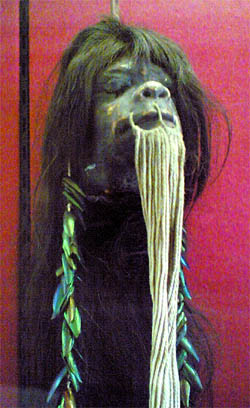
A
head from the Science Museum in London. It has since been
withdrawn from display.(Credit Frankie
Roberto)
|
The
Shrunken Head Trade
In the late 19th century Europeans and Americans,
hearing stories about the Jivaro and their unusual traditions,
started buying shrunken heads as curiosities. The going rate
by the1930's was about $25 per head. The tribesmen soon learned
that they could obtain money or a firearm in trade for a tsantsa.
The use of guns led to an increased number of more deadly feuds,
which in turn created more heads for the trade. Because the
demand for shrunken heads by tourists was actually causing the
Jivaros to do more headhunting, the governments of Peru and
Equator enacted strict laws forbidding the buying and selling
of tsantsa in order to slow the slaughter. In the 1940's the
United States also banned the import of shrunken heads.
Fakes
With the demand for souvenir shrunken heads high
and the supply restricted by law, a counterfeit market soon
developed. Some were produced by using goat, sloth or monkey
skin fashioned into the shape of a human head. Experts trying
to determine if a head is a fake will look at the shape and
detail of the ears which are hard to duplicate.
During the early 20th century some counterfeit
shrunken heads were produced not by the Jivaro, but thousands
of miles away in Panama. These fakes often involved real human
heads taken from unclaimed corpses obtained at hospitals or
morgues. To tell these heads from authentic tsantsa experts
look for signs that the work was done by someone other than
a Jivaro. The Jivaro used heavy cotton string to sew the mouth
and back of the neck closed, not thin thread. On a true Jivaro
shunken head the lips also bear the marks of the wooden pins
used to seal the mouth during the preparation process. In general,
the work on a tsantsa appears much neater and cleaner when the
work is done by forgers, as the Jivaro did not have access to
modern tools and equipment.
Even with careful examination, however, connoisseurs
have been fooled by clever fakes. Some experts estimate that
most of the shrunken heads held in many museums today are not
real, but forgeries.
|
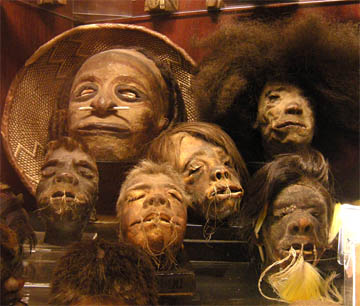
Shrunken
heads on display at Ye Olde Curiosity Shop, Seattle,
Washington. They are most likely a mix of real and fake.
(Credit Joe Mabel licenced through GNU
Free Documentation License)
|
Today, replicas of tsantas (usually made from
animal products) are still sold, but are clearly labeled as
fakes. Fortunately, the Jivaro tradition of making tsantsas
from real human heads is, hopefully, completely gone now. As
the 20th century wore on, missionaries penetrated the Jivaro
territory, Christianized them, and their extremely murderous
ways eventually departed. Now, though occasionally some sloth
heads are prepared in the tsantsa fashion, the warring to obtain
trophy heads is only part of a macabre history.

Copyright Lee
Krystek 2011. All Rights Reserved.